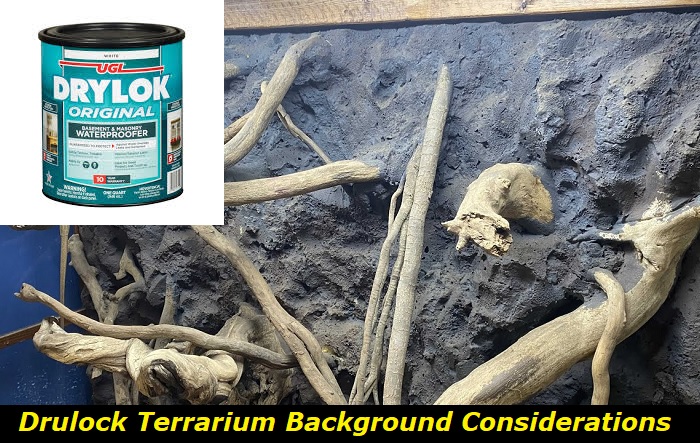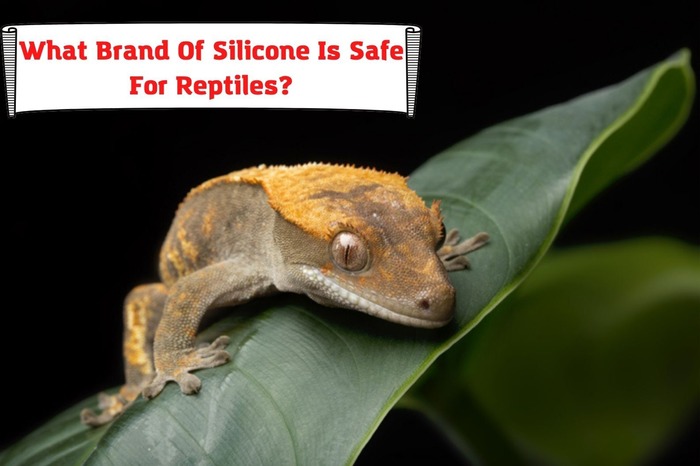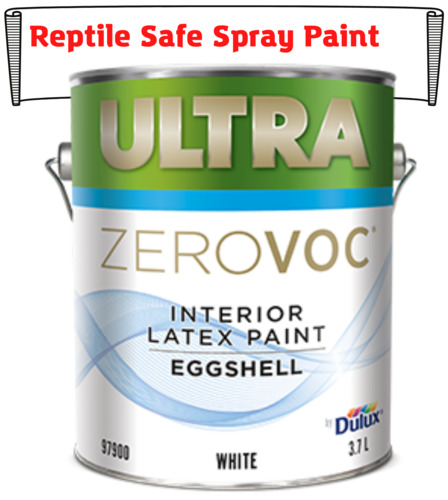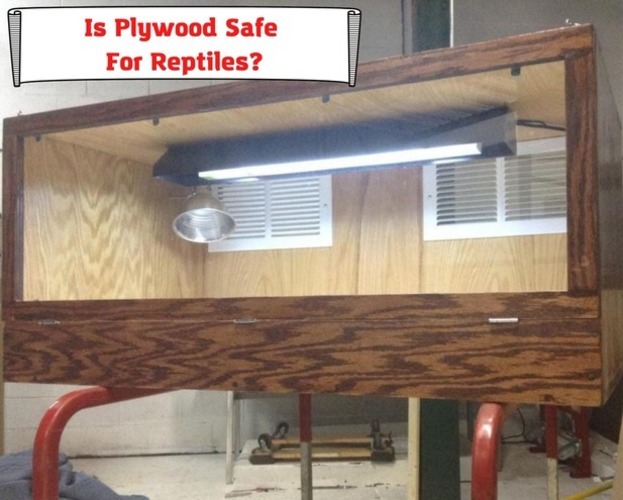A good home matches the needs of its occupant. More than that, it is also clean and safe.
Different terrariums require different environments depending on the type of pet we have.
Despite this variance, all terrarium owners know that the safest environment for their enclosed companions is waterproof.
Waterproofing a terrarium makes it easy to maintain constant water levels circulating within the enclosure. Not only does this make our pets safe, but it also gives them a sense of stability.

What is the Drylok Terrarium background?
Drylok is an incredible waterproof sealant used by DIYers, homeowners, and pet owners. It is odor free and can protect any constructed surface from water penetration. In terrariums, it largely makes sure that water from the outside stays out of the enclosure.
It does this by penetrating surface pores and pinholes, bonding to the background surface, and creating an impenetrable barrier between the surface and the enclosure.
The Drylok sealant uses a fast-setting formula that enables it to dry to the touch in two hours and be ready for recoating in three hours.
Apart from waterproofing, pet owners also use Drylok to create false items, such as rocks, for their backgrounds.
How to use Drylok?
1) Assemble what you will need
Gather all the items you will require to build your terrarium. Have fun with this step: pick out the items that will make your terrarium match your imagined vision. For example, if you want a tropical background, pick out decomposed wood.
Lay out your items and tape them at your desired points. You can use expanding foam to attach them to the terrarium walls and create a landscape. After curing, the foam should be bubbly on the inside and smooth on the outside. Carve out the foam to expose the porous interior of the foam. This will also make the Drylok adhere easily to the walls of your terrarium.
2) Preparing the surface
While you can use Drylok on moist surfaces, it is best applied to dry surfaces. Wipe your terrarium down to remove any dust, lint, grease, and oils. Remove old paints by scrubbing them down with a wire brush.
Patch all cracked surfaces with a trusted sealant. Smoothen the plugged holes and cracks until they are even with the surrounding surface or until they are your desired shape.
3) Application
Stir the Drylok thoroughly until you achieve an even consistency of the paint. Do this periodically before and during the application, and make sure that you do not add water or any other fluid or substance to thin it. It is essential that it is used as it is to prevent product failure.
If you want to customize your background with color, mix in a reputable concrete dye while stirring. Remember that the paint will be lighter than it appears when stirring once it dries.
Apply the first coat to a dry, clean, and bare background. Use a high-quality brush for the application, preferably a nylon brush, and make sure that all pores, pinholes, and cracks are sufficiently covered.
The paint will take 1 ½ hours to dry to the touch, but give it 3 hours from application to apply the next coat.
Apply the next coat using a roller or a brush. For proper coverage, a minimum of two coats is advised. After the second coat, inspect the surface for any uncovered areas, such as pinholes you might have missed, and apply another coat of paint to these stubborn areas.
Your background should be even after drying. Leaking at this point suggests the presence of uncovered pinholes underneath. Stay calm and then paint over those areas again. You want to be extremely thorough in your application to ensure that the Drylok performs as it is intended to.
It is advised that you allow your background several days to allow the Drylok to dry properly. Extra time might also give you time to notice any defects that need correction.
Things to consider when using Drylok for your Terrarium Background;
There are a number of factors that will determine whether Drylok is the best choice for your terrarium. These are listed below.
1) Your pet’s needs
The choice to use Drylok hinges heavily on the needs of your pet. While animals such as frogs, snakes, and bearded dragons might appreciate using Drylok in the background, other animals that are more active or sharp-clawed might only be somewhat comfortable.
2) Color
Drylok comes in neutral colors of white and gray. Should you want the Drylok to match the color of your visualized landscape, it is best to ask for assistance from your nearest trusted professionals.
3) Durability
Drylok works great with some forms of base materials, such as foam. It is important to do your own extensive research on what kind of base is best for the sealant. This will also depend on how you want your landscape to look like, and what is best for use in your terrarium.
Drylok can withstand a lot of hydrostatic pressure while ensuring that an enclosure is completely waterproofed. During your application, you will need to be thorough to ensure the Dylok properly adheres to your background and covers every corner.
Is Drylok safe?
Drylok is safe for use in terrariums where plants and certain types of reptiles are housed. Low-activity reptiles such as snakes and frogs will love a Drylok setup, but reptiles that like to scratch or claw the ground might have a bit of a challenge. It is always better to err on the safe side with our animals, so exercise caution while applying Drylock.
Ensure that you use enough coats for your surface and leave enough drying time between coats, and your pet will be fine. Without proper drying, the paint may not hold up well, and you risk harming your pet.
Drylok should not be used for aquatic animals under any circumstances. Ensure that you read the technical sheet that comes with the paint. Drylok has firmly stated that it is not safe for enclosures that require to be filled with water. Some pets that need to be periodically exposed to water might also run the risk of being in danger.
Conduct thorough research on your reptile to determine what they need best. The toxic effects might be long-lasting for aquatic life or animals that require resting water pools in their enclosures.
Carefully observe your pet for any signs of unusual illness, and take quick action if The Drlok poses a problem.
Dangers of using Drylok
1) It might cause harm to aquatic life
The technical sheet that accompanies the Drylok paint states that Drylok should not be used for aquatic life. This rule may also apply to pets that require standing water bases in their enclosures, such as frogs and turtles.
Long exposure of Drylok to standing water may contaminate the water, making it harmful to your pets.
Pay close attention to your pet for any signs of illness. It may be better to use other sealants if your pet reacts badly to the Drylok.
2) It might result in mold growth
Using Drylock poses the risk of mold growth in your terrarium. In its technical sheet, Drylock states that some of the chemicals in its formula are a conducive breeding ground for mold.
While most terrarium enthusiasts have reported no issues with mold growth, it is important to know as much as there is to know about a product that your pet will be constantly exposed to.
To prevent mold growth in your terrarium, there are two things that you need to keep your eye on. The first is humidity levels. Perhaps there is a constant source of moisture in your terrarium, such as a wet substrate, you will need to ensure that you constantly keep it dry or introduce a working drainage system into your terrarium.
The second issue is light levels. Mold thrives in areas of low light concentration. Ensure that you know your terrarium like the back of your hand. Introduce proper lighting into the enclosure to reduce the chance of mold developing.
If you notice mold in the enclosure, remove your pet from the enclosure immediately and take it to the vet. Scrape down the terrarium to detach the mold from the surface. It is safer to have your pet outside of the immediate surrounding while removing the mold. Do not continue to expose your pet to mold.
Some of the signs of mold-related illness in pets could include; lack of activity, unusual noises while breathing, broken skin, sores, or strange inactivity.
Conclusion
Any terrarium owner will rest assured knowing that Drylok provides a highly durable and water-resistant barrier for their enclosed pet.
It is safe for low-activity reptiles. Caution should be exercised for high-activity animals or scraping pets. You may need an alternative sealant for such pets.
Drylok should not be used for aquatic animals or animals that spend a considerable time in water under any circumstance.
Be careful when applying the Drylok; follow all the required guidelines, and you will be good to go.
- Pacman Frog Looks Deflated – What’s Wrong and What to Do? - August 7, 2023
- How to Put Snake Back in Cage after Feeding? Important Concerns - July 31, 2023
- Repta Boost: Instruction, Considerations, Ways to Use - July 24, 2023



